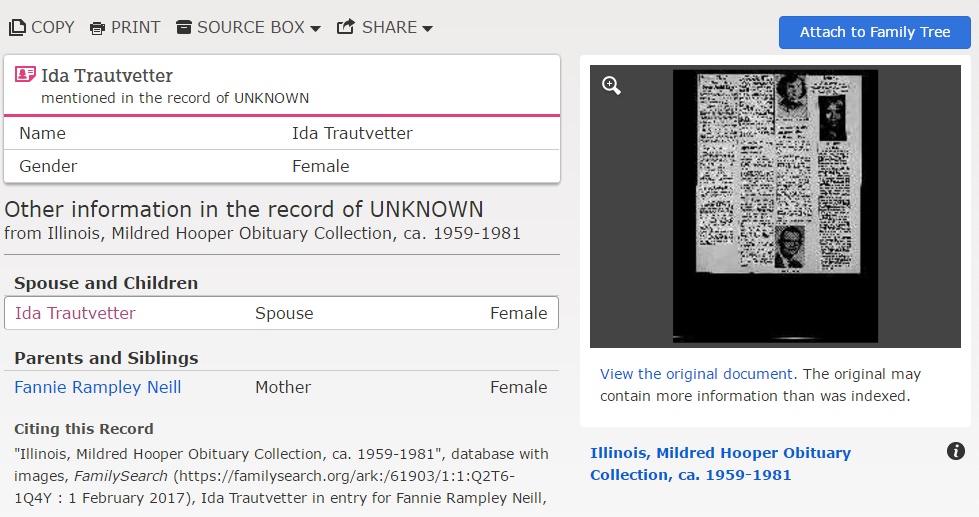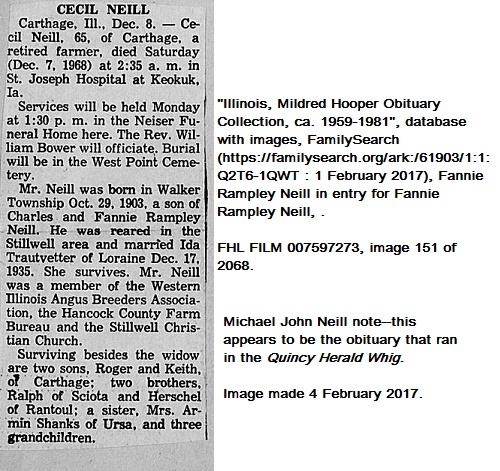If FamilySearch, Ancestry.com, or any other site has the actual image of a record on their site, that’s what I use to create my citation and to extract to put information into my own database.
My grandmother (under her maiden name) appears in FamilySearch‘s “Illinois, Mildred Hooper Obituary Collection ca. 1959-1981.” The database entry for Ida Trautvetter indicates that Fannie Rampley Neill is her mother.
How they arrived at that is questionable. The first illustration to this post is the record entry for Ida Trautvetter in this database. The FamilySearch suggested citation is included. Since this database entry links to an obituary from which the “information” was taken, I’m not even going to worry about putting this information in my files. The reason is not that the information is incorrect (which it is), but that it is information that has been extracted from the actual obituary. This is not an index entry that adds information and should be cited as a source of its own. It is a finding aid.
The information was taken from an obituary for my Grandfather Neill.
I am not certain how the information was interpreted so that Fannie was seen as the mother of Ida. I’m not certain I even want to know. Indexes are meant to be finding aids. The creators of indexers unfortunately do not always critically analyze what they are indexing. That’s really not their job. Indexes are meant to point researchers to records.
I’ve created a new image with the obituary (as it appears in the “Illinois, Mildred Hooper Obituary Collection, ca. 1959-1981”), the source (as suggested by FamilySearch), the film number, the image within the images number, and my comments. Before I enter the information from these records into my database, I need to decide how clippings from this collection should be sourced. I’m not going to want to do that while I’m making discoveries in the database and don’t want to delay searching while I figure out the citation (let’s be realistic here), but all the information will help me to make that citation. The limitation to “waiting” to enter this in my database and make citations is that I will have to manually type in much of the citation information as it cannot be copied and pasted from this image.

But I’m not even going to cite this image or use this it in my database. It’s not because there is anything wrong with this image copy of the obituary.
Itis because I already have an actual newspaper copy. There’s no need for me to cite a digital image of it as well. For those images I don’t already have, I’ll use the digital image as I’m not going back to find each original item in the newspaper where it appeared.

3 Responses
I have 2 questions regarding the last paragraph.
1 – IF a person is close or has the the time to find the news article on microfilm (and of course the quality is the same), would it be better to cite the original source with the newspaper name, date, column, etc.? My thinking is the possibility of this collection not being available or the URL gets changed in the future.
2 – If there are 2 (or more) newspapers that publish a news article, but one is more detailed than the other. How do you handle that? My Mother was originally from Camp Point, so the Camp Point paper had more info than did the Quincy paper. Do you include both obits or the more detailed one with a note that a less detailed obit can be found in the … paper?
Thanks for giving us these tidbits to help in our research too.
If I could easily find the original (on microfilm), then I’d cite that as it clearly indicates what newspaper it actually came from. In this specific case, since there may be MANY of these I may use, I might not bother and would cite the collection. I would download images from the database for any item I cited. In this case, I might make a note as to what newspaper I think the item is from–if I have a good guess. I can usually tell in this case if something is from the Quincy Herald-Whig during this time period.
As to your second question, chances are the same person provided information to both papers (either directly or indirectly via the funeral home during the time period in question). Generally the smaller paper would have more information and I would use that and cite that–since what’s probably in the Quincy paper is a shortened version of what’s in the Camp Point paper. One can (in my opinion) get a little too carried away citing every little piece of paper (after all there could be other nearby weeklies that included a death notice or short obituary as well–how many should be cited or located? During the right time period, there may be a mention of some sort in the Golden paper, the Mendon paper, etc.-most of which are repetitive–probably).
I include both articles and have separate citations for each. This assumes the two articles have different wording and information. If the two are duplicates, I like to use the paper that was closer to the person’s hometown.
I cite the name, date, page column etc and will make a notation about the database I found it in. That way, future researchers using my info can look at the paper and see the article in whatever database they have access to. The reason I include mention of the database if I did online research is so that the person looking at my records will know I was using a database instead of having the actual newspaper in my hand.